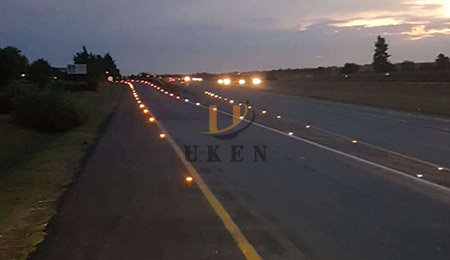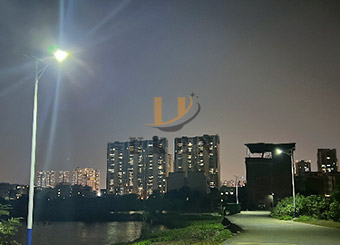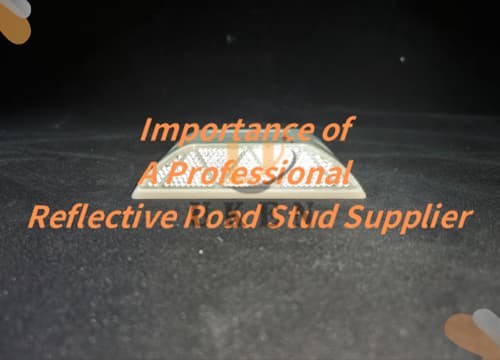As the core hub of modern traffic, highways carry a large number of high-speed vehicles every day. In such a traffic environment, the clarity of the road marking is directly related to driving safety. Data show that at night and under bad weather conditions, the percentage of traffic accidents caused by unclear road signs is as high as 40%. Traditional road marking in the rain, fog, sand and dust and other environments, its visibility will be greatly reduced, difficult to meet the highway safety marking of the stringent requirements.
Reflective road studs have become a key facility for improving safety on motorways due to their unique optical reflection principle. When illuminated by vehicle lights, reflective road studs can efficiently reflect the light back to the driver’s field of vision, clearly outlining the road at night and in bad weather. This article will work from the principle, core advantages, product types and other dimensions, comprehensive analysis of the value of reflective road studs in the application of highways.
Glass bead reflection principle
Reflective studs in the high refractive index glass beads is to achieve the core components of light reflection. When the vehicle light irradiation to the surface of the glass beads, the light first into the glass beads, after refraction and focus to the back of the glass beads reflective layer, and then reflected back to the original direction of the light source. The particle size and density of the glass beads directly affect the reflection effect: the smaller the particle size, the more concentrated the light focus; the higher the density, the more light reflected per unit area.
Reflective film working mechanism
Reflective film studs use a micro-prismatic structure for efficient reflection. The micro-prism is able to reflect and refract the incident light several times inside, and reflect the light back to the driver’s line of sight even when the incident light is at a large angle. This design allows the film to maintain stable reflective performance in a variety of environments.
Housing Material Characteristics
The housing of reflective studs is usually made of engineering plastics or metal alloys. Engineering plastics are lightweight, corrosion-resistant and resistant to UV rays and chemicals, while metal alloy housings are more crush-resistant and can withstand repeated crushing by heavy trucks. The use of these materials ensures that the Stud will last in the complex environment of the motorway.
Optical angle optimisation
The reflective surface of the Stud is precisely angled, typically at 30°-45° to the horizontal. This angle ensures that light is effectively reflected into the driver’s field of vision in all directions and at all distances. At the same time, the curvature of the surface of the road Stud design can also reduce the diffuse reflection of light, improve the efficiency of reflection.
Clear marking at night
In the night without street lights or dimly lit road sections, reflective road studs with the help of vehicle headlights, can form a bright point of light, clear marking lane boundaries and road contours. Research has shown that after installing reflective road studs, the driver’s recognition distance of road markings can be increased by more than 3 times, which significantly reduces the risk of accidents at night.
Adaptability to Adverse Weather
In rain, fog, sand and dust, and other bad weather visibility of less than 50 metres, reflective road studs can still maintain a good reflection effect. The water film formed by the rain on the surface of the Stud enhances the focusing effect of the glass beads, while the specially designed reflective film can effectively resist sand and dust coverage, ensuring that the warning function continues to play.
No Electricity Required
Reflective road studs rely entirely on vehicle lights to reflect the light, and do not need to be connected to the power grid, so there is no power consumption. Compared with active light-emitting road studs, the installation cost per kilometre can be reduced by more than 60%, and there is no subsequent expenditure on electricity, which significantly reduces the pressure on road operation costs.
Easy installation and maintenance
Reflective road studs installation process does not require complex wiring, embedded studs only need to be fixed by punching holes, stick-on studs through the special glue can be quickly installed. Routine maintenance only requires regular cleaning of the surface dust and checking the fixing condition, and the replacement time of a single Stud is less than 5 minutes, significantly reducing the cost of manual maintenance.
Crush Resistance
Reflector Studs are specially designed to withstand up to 20 tonnes of vehicle crush. The internal structure is reinforced so that even if the shell is slightly damaged, the core reflective component remains intact, ensuring that the warning function is not compromised.
Weatherproof
The stud housing is IP68 rated and can operate in extreme temperatures ranging from -40°C to 80°C. The stud housing is also weatherproof. Whether it is hot and sunny or freezing cold, the reflective performance and structural strength of reflective road studs will not be significantly reduced.
Glass bead-type reflective studs
Glass bead-type road Stud cost is low, suitable for traffic flow moderate highway sections. Its advantage is that the reflective effect is stable, but after long-term use of glass beads may be worn down due to reflectivity decline. It is recommended to carry out a comprehensive inspection every 3-5 years, and replace the studs with serious wear and tear in time.
Reflective film-type reflective road studs
Reflective film-type Studs have a wider reflection angle and higher reflection efficiency, especially suitable for curves, ramps and other special road sections. The high-performance reflective film can last for 8-10 years, and the reflective performance in wet environment is better than glass bead-type Studs.
Embedded reflective studs
Embedded studs are fixed on the road surface by drilling holes, flush with the road surface, and are suitable for the main carriageway of motorways. During installation, holes are drilled into the road surface to a depth of about 5-8 cm, and then the base of the Stud is fixed with high-strength glue to ensure its stability.
Surface-mounted Reflector Stud
Surface-mounted studs are glued directly to the road surface with special glue, making them easy to install and suitable for temporary roads, construction areas and other scenarios. Before pasting to ensure that the road surface is dry and clean, the use of strong adhesive can ensure that the road Stud in 6-8 months to remain firm.
Lane Separation
In the main lane of the motorway, reflective road studs are arranged at a spacing of 15-20 metres, clearly delineating the lane boundaries. When driving at night, the continuous reflection of light points to help drivers maintain a correct driving trajectory, reducing the illegal lane change caused by cuts and accidents.
Road Edge Warning
Reflective road studs installed at the road edge can effectively remind drivers of the road boundary. In long straight road sections, the warning effect of road studs can prevent vehicles from driving off the road due to driver fatigue.

Curves and Slopes
On sharp curves and steep slopes, reflective road studs are used to guide drivers to slow down in advance by creating a continuous arrangement of curve profiles. Studies have shown that the average passing speed of vehicles in curved areas with reflective Studs is reduced by 15 per cent and the accident rate is reduced by 28 per cent.
Tunnel Entrance and Exit
The entrance and exit areas of tunnels are prone to visual discomfort due to sudden changes in light. Reflective road studs are placed in this area to help drivers adapt to light changes through continuous reflection of light, reducing the potential safety hazards of the ‘black hole effect’ and the ‘white hole effect’.
Construction areas
In motorway construction zones, Surface Mounted Reflective Studs can be quickly deployed to form temporary warning signs. The yellow flashing studs can effectively guide the vehicle diversions, to protect the construction workers and the safety of passing vehicles.
Performance comparison
| Compare Projects | Reflective road studs | Active luminous road stud | Ordinary road marking |
| Visibility | Relying on the reflection of vehicle lights, the effect is good at night |
Active luminescence, visible all day long |
Poor performance at night and in bad weather |
| Energy demand | none | Power supply required | none |
| cost | Low | high | Lower |
| Maintenance frequency | Low | Higher | Higher |
Initial investment
The initial investment for reflective studs is about RMB 8,000-12,000 per kilometre, while that for active illuminated studs is as high as RMB 25,000-35,000. Although the initial cost of ordinary road marking is low, it has a short service life and requires frequent re-striping.
Long-term operation
Taking 10 years as the cycle, the comprehensive cost of reflective road studs is the lowest. Its low maintenance costs and long service life, so that it shows significant economic benefits in long-term operation, especially suitable for highway projects with limited budget.
Preparation
Before installation, use a laser range finder to ensure that the spacing of the road studs is even. At the same time, use a high-pressure water gun to clean the road surface, remove oil and dust, to ensure that the installation surface is dry and flat. Prepare installation tools and materials such as electric drill, screwdriver, Stud, high strength glue, etc.
Installation steps
Embedded Stud installation, first drill according to the size of the Stud holes, depth error of not more than ± 5mm, will be placed in the base of the hole, injected into the glue and compacted, to be cured after the installation of the main body of the Stud. Paste-type studs need to be evenly coated on the back of the glue, quickly pressed to fix, to ensure close fit with the road surface.
Quality Inspection
After installation, use simulated headlights to test the reflection effect to ensure that the reflection angle is within the specified range. At the same time, check the firmness of the road Stud, shake the Stud without loosening before acceptance.
Daily inspection
Weekly inspection, focusing on checking the surface cleanliness and fixation of the Stud. Use a soft brush to clean up dust and stains on the reflective surface to ensure that the reflective effect is not affected.
Wear and tear inspection
Monthly wear and tear inspection is carried out on the Studs to determine whether they need to be replaced by comparing the reflective strength of the old and new Studs. When the reflectivity decreases by more than 30%, the Studs should be replaced in a timely manner.
Fixing check
Quarterly check the fixing screws or adhesive parts of the Stud, and reinforce them in time if they are found to be loose or detached. Embedded studs, need to check whether the surrounding road surface cracks, to avoid road deformation affecting the stability of studs.
With high visibility, low cost and strong durability, reflective road studs have become an important facility for highway safety and security. Its unique optical reflection technology and diversified product types can meet the safety needs of different road sections and effectively reduce the risk of accidents. In the future, with the continuous innovation of material technology and optical design, reflective road studs are expected to achieve higher reflective efficiency and longer service life for highway safety.





